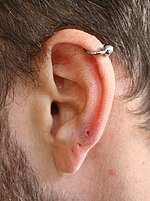Helix piercing
| Helix piercing | |
|---|---|

|
|
| location | Ear edge |
| Jewellery | Labret / Ball Closure Ring Note on Jewelry |
| Healing time | 3 - 6 months (engraved), 2 - 4 weeks (punched) Note on healing time |
| ‣ Topic overview | |
A helix piercing is a piercing on the helix , the bulge-like border of the auricle . At this point, the auricle consists of cartilage tissue .
History and culture
Today, the helix piercing is mainly worn under fashionable aspects in western culture, where it established itself as a rarer variant of the ear piercing , especially during the 1990s, alongside tragus , rook , snug , daith and conch piercing . However, it is also widely used as a traditional piercing among several ethnic groups.
Africa
In Africa, piercing through the edge of the ear is known to numerous ethnic groups. For example in West Africa with the Fulbe , Lobi and Dogon , or in East Africa with the Maasai , Samburu , Pokot and Turkana . It is also worn by the Surma , a people in southwest Ethiopia and the neighboring Sudan.
Mostly it stands as a symbol of wealth and beauty .
The Kikuyu people, who live in Kenya , use pegs with particularly large diameters in the edges of their ears, although several were worn next to each other.
South East Asia
Large holes in the upper edge of the ear are traditionally worn by ethnic groups belonging to the Dayaks in Borneo . For example by hunters of the Iban and the Punan . The canines or claws of bears and leopards are mostly used . The jewelry serves as a symbol of social rank and is also intended to give successful hunters a terrifying appearance.
For older women in Indonesia , a helix piercing is often a sign of maturity.
North America
Forms of helix piercing were known among Indian tribes in North America. For example with members of the Oto , Kansa , Iowa or Pawnee .
Implementation, healing and risks
As with other piercings, the skin area to be pierced is first disinfected . Then the puncture site, usually on the front of the auricle, is marked and pierced with a venous needle (see piercing a piercing ) . The implementation can be more painful than on parts of the body without cartilage.
In the past, the helix piercing was often shot with an ear piercing gun . However, this method is no longer used today because the risks are too high.
The cartilage is not supplied with blood, it belongs to the bradytrophic tissues, which is why the healing can take much longer than, for example, a piercing of the earlobe ( lobe piercing ).
An alternative to piercing with a medical hollow needle is punching . Some of the cartilage tissue is removed, which reduces or eliminates pressure pain and shortens the healing time.
The healing process for a helix piercing usually takes three to six months. If the piercing is punched, this time is shortened to two to four weeks.
Jewellery
A ball closure ring with a material thickness of 1.6 millimeters is usually used as suitable piercing jewelry . Alternatively, however, labret plugs can also be worn. For the first use, a straight barbell is often recommended until it has healed so as not to put additional pressure on the freshly pierced tissue, as can occur with curved jewelry.
If there are several piercings through the edge of the ear, the ear spiral is a fashionable special shape among the jewelry variants. This is a spirally curved barbell that is passed through the individual puncture channels. However, an exact alignment of the individual piercings is necessary. The distances between the individual piercings may have to be adapted to the spiral to be used when piercing.
Variations
The helix piercing can be attached anywhere on the edge of the ear, starting from the point directly above the earlobe to above around the curvature of the auricle. If the piercing is close to the starting point of the ear edge, it is called an anti-helix piercing .
If two opposite helix piercings are connected with a barbell, one speaks of an industrial or scaffold piercing . A helix piercing is often combined with an anti-helix piercing.
A lower helix piercing on the upper edge of the ear is an outer conch piercing . Strictly speaking, however, this is not a special form of helix piercing, but a special positioning of conch piercing . In turn, this is often confused with the helix piercing.
Web links
Individual evidence
- ↑ The helix piercing at www.piercing-arten.de
- ↑ a b Ohr Piercing ABC ( Memento of the original from August 8, 2010 in the Internet Archive ) Info: The archive link was inserted automatically and has not yet been checked. Please check the original and archive link according to the instructions and then remove this notice. at inkland.com
- ↑ a b Body Piercing - Evolution or Revolution? ( Memento of the original from December 12, 2010 in the Internet Archive ) Info: The archive link was inserted automatically and has not yet been checked. Please check the original and archive link according to the instructions and then remove this notice.
- ^ The Piercing Bible, page 12
- ↑ The Helix Piercing ( Memento of the original from April 11, 2010 in the Internet Archive ) Info: The archive link was inserted automatically and has not yet been checked. Please check the original and archive link according to the instructions and then remove this notice. at www.piercing-magazin.de
- ↑ The Outer Conch at www.piercing-arten.de





